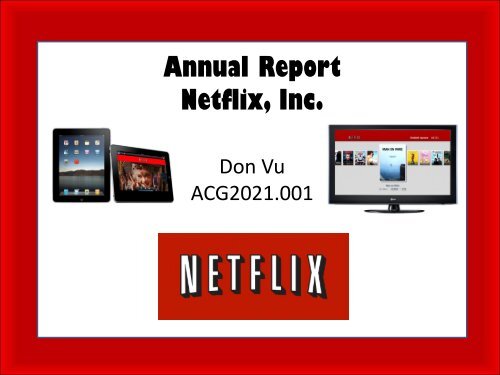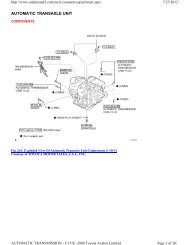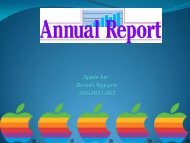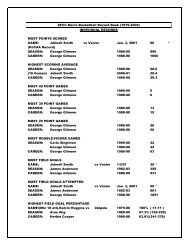Annual Report Netflix
Annual Report Netflix
Annual Report Netflix
Create successful ePaper yourself
Turn your PDF publications into a flip-book with our unique Google optimized e-Paper software.
<strong>Annual</strong> <strong>Report</strong><br />
<strong>Netflix</strong>, Inc.<br />
Don Vu<br />
ACG2021.001
Executive Summary<br />
• <strong>Netflix</strong>, Inc. is a popular subscription service that provides streaming movies and<br />
TV shows over the Internet and delivers DVD rentals. It is one of frontrunners for<br />
streaming entertainment because of its large library content.<br />
• The business has been through a rough patch lately when it lost an estimated one<br />
million subscribers after they increased the price of DVD rentals and Internet<br />
streaming services and separated their services into two websites. After <strong>Netflix</strong>’s<br />
announcement of the change, their stock prices tumbled to about one-third of the<br />
original price .<br />
• With the new pricing plan and reorganization, the company hopes to develop each<br />
of their services better, such as expanding their libraries. They also began reaching<br />
out to international markets such as Canada, Mexico, the Caribbean, Central<br />
America, and South America. They plan to expand to rest of the world in the<br />
future.<br />
• 2010 <strong>Annual</strong> <strong>Report</strong> and Financial Statements
• Chief Executive Officer:<br />
Reed Hastings<br />
• Home Office Location:<br />
100 Winchester Circle<br />
Los Gatos, California, USA 95032<br />
• Ending Date of Latest Fiscal Year:<br />
December 31, 2010<br />
Introduction<br />
• Subscription service for streaming TV shows and movies over the internet, and for<br />
DVD/Blu-Ray rentals through mail delivery. The streaming service is supported on<br />
many devices.<br />
• Provides service to USA and Canada. Slowly expanding to Mexico, the Caribbean,<br />
Central America, and South America.
Audit <strong>Report</strong><br />
• Financial statements were audited by KPMG LLP.<br />
• KPMG LLP concluded that the presentation of the financial statements was<br />
fair and are in accordance to US generally accepted accounting principles.<br />
They also wrote that the internal control of <strong>Netflix</strong>, Inc. was effective over<br />
financial reporting. This was based on criteria set by the Committee of<br />
Sponsoring Organizations of the Treadway Commission in Internal Control-<br />
Integrated Framework.
Stock Market Information<br />
• Price of <strong>Netflix</strong> Inc.’s stock as of<br />
October 6, 2011 at 4:00 PM ET:<br />
$123.24<br />
• 52-Week Low: $107.63<br />
• 52-Week High: $304.79<br />
• Dividend per share: $0.00<br />
(<strong>Netflix</strong>, Inc. has not declared<br />
any dividends yet.)<br />
• While the price is still high, it<br />
has been decreasing rapidly<br />
since the announcement of the<br />
subscription price hike. I would<br />
recommend stockholders to sell<br />
and potential buyers not to buy.<br />
July 2010-October 2011
Industry Situation and Company Plans<br />
• <strong>Netflix</strong>, Inc. is one of leading services in providing TV shows and movies<br />
instantly through Internet streaming. Entertainment through Internet<br />
streaming is a relatively new market, which is highly competitive and<br />
changing constantly. This emerging market will slowly replace DVD rentals<br />
(also a part of <strong>Netflix</strong>’s business). Streaming over the Internet will become<br />
a primary provider of entertainment as consumers are more reliant on<br />
computers and devices that have Internet connection. Also Internet<br />
streaming is convenient and easy for the consumer.<br />
• <strong>Netflix</strong> has split up their Internet streaming and DVD rental services into<br />
two separate companies. <strong>Netflix</strong> will provide streaming content while a<br />
new subsidiary, Qwikster, will provide DVD and video game rentals<br />
through mail. This resulted a 60% price hike for customers who originally<br />
had both services. <strong>Netflix</strong>, Inc. stated that they separated the services in<br />
order to focus on improving each of the services separately like obtaining<br />
new content.
Industry Situation and Company Plans<br />
• <strong>Netflix</strong>, Inc. has an expansion plan to all the other countries in the<br />
Americas besides USA and Canada. The business plans to expand to<br />
foreign markets overseas in the future.<br />
• Source 1, Source 2, Source 3
Income Statement<br />
• <strong>Netflix</strong>, Inc. uses multistep format.<br />
Year Gross Profit Income from<br />
Operations<br />
Net Income<br />
2010 805,270,000 283,641,000 160,853,000<br />
2009 590,998,000 191,939,000 115,860,000<br />
Difference 214,272,000 91,702,000 44,993,000<br />
• Gross profit, income from operations, and net income all increased from<br />
2009 to 2010.<br />
• There were more revenues in 2010 than in 2009, resulting in an increase<br />
in gross profit.<br />
• Although cost of revenues and operating expenses grew in 2010, income<br />
from operations still increased because of the increase in revenue.<br />
• Income taxes and interest expenses also increased but net income still<br />
grew because of more revenue in 2010.
Balance Sheet<br />
Year Assets = Liabilities + Stockholders’ Equity<br />
2010 982,067,000 691,903,000 290,164,000<br />
2009 679,734,000 480,591,000 199,143,000<br />
Difference 302,333,000 211,312,000 91,021,000<br />
•Assets, liabilities, and stockholders’ equity all increased from 2009 to 2010.<br />
•Assets had the greatest change within the two years. An increase in assets<br />
means that <strong>Netflix</strong> is growing in business.<br />
•Liabilities increased but it is not a big concern since the company borrowed<br />
more money to achieve more growth and increase in assets.<br />
•Stockholders’ equity also increased because more people are investing in<br />
<strong>Netflix</strong>, Inc. The new investors recognize that the business is growing.
Statement of Cash Flows<br />
Year Net Income Cash Flow from Operations<br />
2010 160,853,000 276,401,000<br />
2009 115,860,000 325,063,000<br />
•Cash flow from operations was more than net income in the previous two<br />
years.<br />
•The company is growing as it is investing in acquiring more DVD content for<br />
its current library. <strong>Netflix</strong>, Inc. also invested in equipment and property, and<br />
acquisition of intangible assets.<br />
•In 2010, the primary source of financing was tax benefits from stock-based<br />
compensation, and in 2009, it was proceeds from issuance of debt and net of<br />
issuance costs.<br />
•Cash has increased from $134,224,000 (2009) to $194,499,000 (2010).
Accounting Policies<br />
• Revenue Recognition- The business recognizes revenue ratably from monthly<br />
subscription periods. Refunds are revenue reductions. Unrecognized<br />
subscriptions and unredeemed gift card subscriptions are counted as deferred<br />
revenues.<br />
• Cash Equivalents and Short-term Investments- Investments in instruments<br />
purchased with an original maturity of 90 days or less are considered cash<br />
equivalents. Marketable securities with original maturities more than 90 days are<br />
considered short-term investments.<br />
• Content Library- <strong>Netflix</strong>’s content was obtained through DVD purchases and<br />
licensing deals for streaming. Streaming content is amortized over their period of<br />
availability. Licensing fees for titles that are due within a year but not paid yet are<br />
classified as “Accounts payable.” The portion due beyond a year is classified as<br />
“Other non-current liabilities.”<br />
• Property and Equipment- These are carried at cost minus accumulated<br />
depreciation. Leased buildings are capitalized and included when it did not meet<br />
the sale-leaseback criteria.
Accounting Policies<br />
Topics of the notes to financial statements<br />
•Organization and Summary of Significant Accounting Policies<br />
•Short-term Investments<br />
•Balance Sheet Components<br />
•Long-term Debt<br />
•Commitments and Contingencies<br />
•Guarantees-Intellectual Property Indemnification Obligations<br />
•Stockholders' Equity<br />
•Income Taxes<br />
•Employee Benefit Plan<br />
•Related Party Transaction<br />
•Selected Quarterly Financial Data (Unaudited)
Financial Analysis- Liquidity Ratios<br />
Year 2010 2009 Comment<br />
Working Capital 252,388,000 183,577,000 The increase in working capital indicates that the<br />
company can invest more to increase growth.<br />
Current Ratio 1.65 1.81 The current ratio went lower slightly. This means that<br />
<strong>Netflix</strong>, Inc. has more current liabilities in 2010.<br />
Receivable<br />
Turnover<br />
Average Days’<br />
Sales Uncollected<br />
Inventory<br />
Turnover<br />
Average Days’<br />
Inventory on Hand<br />
N/A N/A As a subscription service, <strong>Netflix</strong>, Inc. has no accounts<br />
receivable because subscribers prepay for content. It is<br />
paid off by the time <strong>Netflix</strong>, Inc. earns the revenue. The<br />
average accounts receivable is not available. Thus,<br />
receivable turnover cannot be determined.<br />
N/A N/A Since receivable turnover cannot be calculated, average<br />
days’ sales uncollected cannot be determined.<br />
9.37 times 10.41 times <strong>Netflix</strong> has a content library of DVDs and streaming<br />
content as inventory. DVDs are borrowed and returned<br />
by the consumer, and streaming content is duplicated on<br />
the consumer’s device. The number of times a consumer<br />
accesses <strong>Netflix</strong>’s contents during an accounting period<br />
has decreased over time, probably due to <strong>Netflix</strong>’s<br />
competitors.<br />
38.96 days 35.06 days The average number of days that a consumer views<br />
content on <strong>Netflix</strong> has grown by almost 4 days, as the<br />
consumer has many sources of entertainment to choose<br />
from.
Financial Analysis<br />
Profitability Ratios<br />
Year 2010 2009 Comment<br />
Profit Margin 7.44% 6.94% Sales dollars contributed to net<br />
income increased a small<br />
amount from 2009 to 2010.<br />
Asset Turnover 2.60 times 2.58 times The efficiency of turning assets<br />
into sales has stayed mostly the<br />
same.<br />
Return on Assets 19.36% 17.89% There was a small increase in use<br />
of assets to generate income.<br />
Return on Equity 65.75% 42.42% The business earned more by<br />
about 20% for each dollar<br />
invested by stockholders.
Financial Analysis<br />
Solvency Ratio<br />
Year 2010 2009 Comment<br />
Debt to Equity 238.45% 241.33% The ratio stayed about the same within<br />
the two years. The creditors have<br />
more say than investors do in the<br />
company.
Financial Analysis<br />
Market Strength Ratios<br />
Year 2010 2009 Comment<br />
Price/Earnings per<br />
Share<br />
59.36 times 27.82 times The ratio doubled from 2009 to<br />
2010. Investors expect <strong>Netflix</strong>, Inc.<br />
to continue its success.<br />
Dividend Yield 0.00% 0.00% Dividends per share is $0.00, which<br />
would make dividend yield equal to<br />
0%.

















